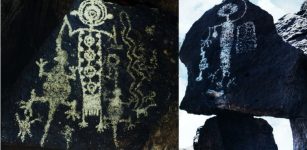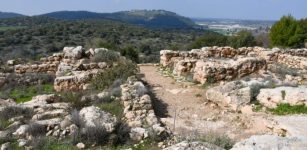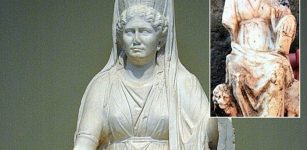Conwy Castle In Snowdonia: Outstanding Medieval Fortification In Europe
A. Sutherland - AncientPages.com - Conwy Castle in Snowdonia is considered one of Europe's most impressive military structures of the late 13th century and early 14th century that survived until today.
Image credit: Adobe Stock - Lukasz Pajor
Kings and feudal lords ruled over their lands from the Middle Ages' grand and massive power centers.
Conway Castle is undoubtedly one of Britain's most impressive and majestic medieval fortresses. It is an impressive fortress and a fortified town, the massive accompanying walls forming an integral portion of the defense.
The town walls "are over a mile in length and are in a singularly good state of preservation; there are twenty-one towers, arranged at regular intervals along this enceinte, and four gates, over one of which is a row of machicoulis, twelve in number, projecting from the upper part of the wall. It was also protected by a dry ditch and with drawbridges placed before the gateways..." 1
The Outer Ward, with the great hall and chapel. Image credit: Albertran - CC BY 3.0
Conwy Castle was built for Edward I, King of England (1272 – 1307), by the master military architect of his age, James of St. George d'Esperanche (c.1230 – 1309). Master James was an architect from Savoy responsible for designing many of Edward I's castles, including Conwy.
The total cost of the new four castles in Wales was more than ten times Edward I's annual revenue, but it was necessary; a revolt could break out at any time.
The site for the construction of the Conwy Castle was perfectly chosen. The structure was a masterpiece of design. Conwy Castle was previously occupied by Aberconwy Abbey, located on a hill looking over the critical crossing over the River Conwy.
This famous medieval fortress is exceptionally well preserved. It contains the most intact set of medieval royal apartments in Wales. The high curtain wall and eight lofty towers built over 700 years ago are still impressive.
Reconstruction of Conwy Castle and town walls at the end of the 13th century. Model located in Conwy Castle. Image credit: Hchc2009 - CC BY-SA 3.0
Based on ancient sources, Conwy Castle and the associated walled settlement – a garrison town - were built within five years under the leadership of Master James and 1,500 craftsmen working at the construction site.
Two barbicans (fortified gateways), eight massive and 21-meter high towers, and a great bow-shaped hall all sit within its distinctive elongated shape due in part to the narrow rocky outcrop on which the castle stands.
No concentric walls within walls were needed in this mighty military fortress.
The strength and inaccessibility of Conwy Castle come from the massive rock on which it stands. The castle has a postern gate leading down to the river, allowing resupplying from the sea.
The rectangular castle is built from local and imported stone material and occupies a coastal ridge, initially overlooking a crossing point over the River Conwy.
'
Conwy Castle is seen from the west, showing the barbican guarding the Outer Ward. Image credit: David Dixon - CC BY-SA 2.0
The outer wall remains with a great hall, chambers, kitchen, an Inner and Outer Ward, private, well-lit, heated rooms, and a royal chapel. The inner ward was a private area for King Edward and his queen, Eleanor of Castile, and the family.
There were only two approaches to the castle; the most important was the main entrance in the form of a high stone ramp, running up towards a swinging or pivoting "drawbridge"; the ditch was 28 feet deep from the drawbridge to the bottom.
Over the next few centuries, the castle played an important part in several wars. In 1665, the castle was ruined entirely; in the late 18th and early 19th centuries, it became an attractive destination for artists, and today, it's a tourist attraction.
Written by – A. Sutherland AncientPages.com Staff Writer
Updated on January 29, 2024
Copyright © AncientPages.com All rights reserved. This material may not be published, broadcast, rewritten or redistributed in whole or part without the express written permission of AncientPages.com
Expand for referencesReferences:
- Ashdown, Charles H., British Castles
K. Ralls-MacLeod,I. Robertson,The Quest for the Celtic Key
More From Ancient Pages
-
 Zeus – ‘Cloud Collector’, God Of Order, Law And Justice – Most Powerful God Of Olympian Pantheon
Featured Stories | Jan 3, 2019
Zeus – ‘Cloud Collector’, God Of Order, Law And Justice – Most Powerful God Of Olympian Pantheon
Featured Stories | Jan 3, 2019 -
 How Emma Of Normandy Risked Her Life To Save England
Featured Stories | Mar 20, 2021
How Emma Of Normandy Risked Her Life To Save England
Featured Stories | Mar 20, 2021 -
 Face Of Man From The Lost Medieval Village Of Dzwonowo Reconstructed Using 3D Printing Technology
Archaeology | Jul 20, 2020
Face Of Man From The Lost Medieval Village Of Dzwonowo Reconstructed Using 3D Printing Technology
Archaeology | Jul 20, 2020 -
 New Last Ice Age Findings In Palawan Cave
Archaeology | Sep 19, 2022
New Last Ice Age Findings In Palawan Cave
Archaeology | Sep 19, 2022 -
 Outstanding Unfinished Ancient Marble Carving Of A Lion’s Head Found Near Selinunte, Sicily
Archaeology | Sep 2, 2023
Outstanding Unfinished Ancient Marble Carving Of A Lion’s Head Found Near Selinunte, Sicily
Archaeology | Sep 2, 2023 -
 Engraved Trees Are Living Records Capturing The Rich History And Traditions Of The Sámi People
Archaeology | Nov 21, 2024
Engraved Trees Are Living Records Capturing The Rich History And Traditions Of The Sámi People
Archaeology | Nov 21, 2024 -
 Ancient History Of The Christmas Tree And Its Pagan Roots – How The ‘Forbidden’ Tree Survived Against All Odds
Christmas Traditions | Dec 24, 2024
Ancient History Of The Christmas Tree And Its Pagan Roots – How The ‘Forbidden’ Tree Survived Against All Odds
Christmas Traditions | Dec 24, 2024 -
 Previously Unknown Monumental Etruscan Temple Found Near The Tempio Grande, Vulci, Latium, Italy
Archaeology | Nov 10, 2022
Previously Unknown Monumental Etruscan Temple Found Near The Tempio Grande, Vulci, Latium, Italy
Archaeology | Nov 10, 2022 -
 North America’s First Languages Originate From Siberia
Linguistic Discoveries | Apr 10, 2024
North America’s First Languages Originate From Siberia
Linguistic Discoveries | Apr 10, 2024 -
 Coca-Cola Was Invented As A Cure For Headache And Hangover In The 1880s
Ancient History Facts | Oct 23, 2017
Coca-Cola Was Invented As A Cure For Headache And Hangover In The 1880s
Ancient History Facts | Oct 23, 2017 -
 A Glimpse Into The Past – Sights And Sounds Of St. Paul’s Cathedral Recreated
Archaeology | Oct 8, 2021
A Glimpse Into The Past – Sights And Sounds Of St. Paul’s Cathedral Recreated
Archaeology | Oct 8, 2021 -
 Viking Grave And Sword Discovered In Norwegian Garden
Archaeology | Jul 3, 2023
Viking Grave And Sword Discovered In Norwegian Garden
Archaeology | Jul 3, 2023 -
 Mysterious Coso Petroglyphs In California – Made By Whom And For What Reason?
Featured Stories | Dec 31, 2020
Mysterious Coso Petroglyphs In California – Made By Whom And For What Reason?
Featured Stories | Dec 31, 2020 -
 Ancient Solar Eclipses That Re-Wrote History And Made Ever-Lasting Impact On Humans
Featured Stories | Aug 15, 2017
Ancient Solar Eclipses That Re-Wrote History And Made Ever-Lasting Impact On Humans
Featured Stories | Aug 15, 2017 -
 Ancient African Empires’ Impact On Migration Revealed By Genetics
Archaeology | Mar 31, 2023
Ancient African Empires’ Impact On Migration Revealed By Genetics
Archaeology | Mar 31, 2023 -
 Unique Page From Rare Illuminated Manuscript And Thousands Of Treasures Found Under The Floor Of Oxburgh Hall
Archaeology | Aug 18, 2020
Unique Page From Rare Illuminated Manuscript And Thousands Of Treasures Found Under The Floor Of Oxburgh Hall
Archaeology | Aug 18, 2020 -
 Story Of David And Goliath Linked To Horvat Qeiyafa In The Valley Of Elah, Israel
Archaeology | Feb 22, 2022
Story Of David And Goliath Linked To Horvat Qeiyafa In The Valley Of Elah, Israel
Archaeology | Feb 22, 2022 -
 Marble 2th Century AD Statuette Of Goddess Cybele Unearthed In Bulgaria’s Plovdiv
Archaeology | Nov 5, 2019
Marble 2th Century AD Statuette Of Goddess Cybele Unearthed In Bulgaria’s Plovdiv
Archaeology | Nov 5, 2019 -
 How Did Canada’s Oldest Coin Make Its Way To Newfoundland’s South Coast?
Archaeology | Nov 14, 2022
How Did Canada’s Oldest Coin Make Its Way To Newfoundland’s South Coast?
Archaeology | Nov 14, 2022 -
 Early Neolithic High Mountain Settlers Were Busy With Complex Livestock And Farming Activities – New Study
Archaeology | Dec 22, 2023
Early Neolithic High Mountain Settlers Were Busy With Complex Livestock And Farming Activities – New Study
Archaeology | Dec 22, 2023




